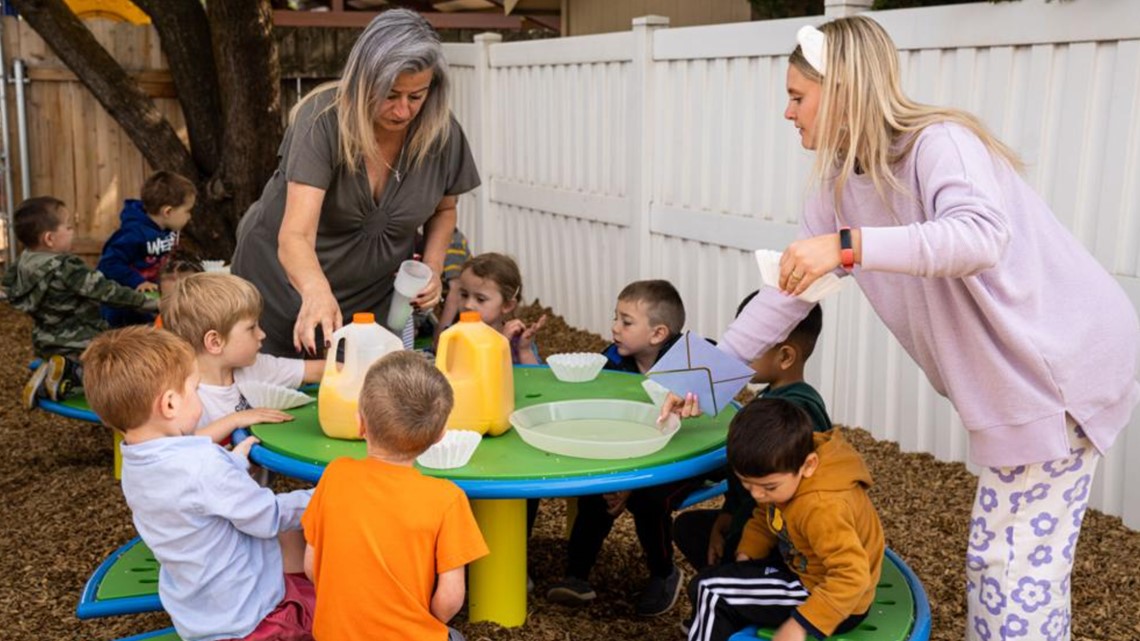BOISE, Idaho — This article originally appeared in the Idaho Press.
Parents looking for daycare for their kids often find themselves on several waitlists before getting care, which most providers attribute to a staffing shortage.
Over the past couple of years, daycare owners like Mia Barron, who owns A Child’s Heart Learning Center in Boise, frequently get calls from “frantic” parents whose daycares have recently closed because of a worker shortage. Barron ultimately has to turn many parents away, because she doesn’t have enough staff to take more kids.
“I’ve been in the childcare business since 2008 and I’ve never experienced such difficulty getting staff,” Barron said.
Daycare facilities have to maintain a ratio of kids to adults: one adult can care for five infants, six 2-year-olds, 10 3- to 4-year-olds or 12 kids age 5 and up. When a daycare doesn’t have the staff to care for more kids, they have to turn parents away. Barron currently has 28 employees servicing 80 children.
She’s one of the lucky ones.
Linda St. Clare, owner of Wonderland Early Learning Center in Boise, has had such trouble with staffing that she doesn’t bother with it anymore.
“Paying $15 an hour is too much for help that stays on their cell phones and does very little with education,” St. Clare said.


She and her husband single-handedly run the learning center, caring for 12 kids. St. Clare has had staffing issues since 2015, the same year she decided to be licensed for 12 kids instead of 30. Cutting down on staff was about the quality of staff, but it was also about affordability. It’s difficult to maintain staff and offer affordable childcare.
St. Clare charges $725 a month for kids who are potty trained, $825 for kids who aren’t. Babies, she said, are the hardest to place in daycare.
“The first year here, I was turning away five to seven babies a day,” she said.
Linda Woll, who owned a small daycare in Boise for 34 years, decided to close her business early in 2022 because she had not been able to hire new employees.
Woll had ads out to hire new employees for months before calling it quits. Her situation is not unique.
Before the pandemic, Woll had 25 kids in her daycare. After the pandemic, they only had 12.
“No daycare has built back up (since COVID), and not because they don’t get calls for kids. I had calls all the time,” Woll said. “It’s because we didn’t have anyone that we could hire. You have to keep that ratio, so if you add two or three kids, you’re going to have to have more teachers.”
The lack of staff was what led to Woll closing her business, and what causes other daycares to operate at a smaller capacity than their building has space for.


Even though Barron is not in the same position as Woll, she agrees that daycare has changed dramatically.
“In the past, it was a lot easier,” Barron said. “There were a lot of people that were interested in this type of job, but it’s hard work. And it takes heart, it takes someone that really does see how important children are. If they’re looking for easy, this is not it.”
Since the job is getting more and more difficult, daycare facilities often try to compensate for the low pay.
“We have to work at it a lot harder. We have to have a good culture, we have to have great training. We have to make sure that we are pouring into these individuals on a regular basis,” Barron said.
At Barron’s learning center, childcare for an infant for five days a week costs $262, while a 4-year-old can get care five days a week for $214. Her employees are paid at least $13 an hour and directors are paid $28.
“We’ve created a career ladder, because we want our employees to see that this could be a career,” Barron said. “This is a teaching job. And it’s not babysitting: it’s educating young kids. The first three years of life are so critical as far as what they’re taught and what they’re exposed to, so we see it as a very important job.”
Although Barron has staff that sticks around, the waiting list for kids lingers. Right now, infants have to wait until October to get into the center.
“Centers are having to close because if you can’t maintain the ratio and you don’t have enough workers on site, you cannot legally care for those children,” Barron said. “If you have no workers, you have no business.”
This article originally appeared in the Idaho Press, read more on IdahoPress.com.
Watch more Local News:
See the latest news from around the Treasure Valley and the Gem State in our YouTube playlist:



